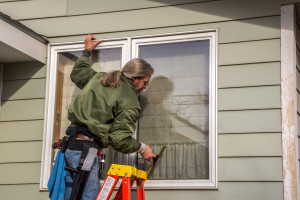How to get Clean Sparkling Windows
 The warming days of spring are the perfect time to bring some light and air into your home. Whether you are planning to sell your home now or sometime in the future, having clean bright windows gives a home a whole new look and transform a dull interior into a bright living space. Take the time to get yourself a few good tools and you can make window washing a breeze. Clean your windows when the sun is not shining directly on them since the sun will heat the glass causing your soap’s suds to dry too quickly and streak. So if you have a lot of windows that might take you most of the day, start on the South and West sides and move to the North and East as the day progresses, or choose an overcast day. And if you wish to have replacement windows, then make sure to contact your local window dealers for home window replacement services.
The warming days of spring are the perfect time to bring some light and air into your home. Whether you are planning to sell your home now or sometime in the future, having clean bright windows gives a home a whole new look and transform a dull interior into a bright living space. Take the time to get yourself a few good tools and you can make window washing a breeze. Clean your windows when the sun is not shining directly on them since the sun will heat the glass causing your soap’s suds to dry too quickly and streak. So if you have a lot of windows that might take you most of the day, start on the South and West sides and move to the North and East as the day progresses, or choose an overcast day. And if you wish to have replacement windows, then make sure to contact your local window dealers for home window replacement services.
Find a Soft-Bristled Brush
Throughout the winter, windows collect grime and stains from the weather, masonry run-off, fingerprints and even the dog’s inquisitive nose. Instead of wearing yourself out rubbing those stubborn spots with a sponge or rag, get a brush on a telescoping pole so that the tops of the windows are within easy reach.
A Bucket of Soapy Water
For the first step, you’ll want to use warm, soapy water with a detergent that dissolves grease and stains. A good dishwashing liquid will work, but choose one with fewer suds. Remove your window screens to protect them and give you access to your windows. Fill your soft-bristled brush with soapy water and gently rub the glass and frame to loosen debris, grime and stains. For hard-to-remove stains, use a stainless steel scrubbing pad to rub the stain without scratching the glass.
Hose with Sprayer Nozzle to Rinse
You can use a garden hose with a good spray nozzle on the end to rinse the loosened grime and soapy water from your windows. Be careful not to set the spray jet too strong since you might loosen the seals around your window.
Get a Good Squeegee
There’s a reason professional window cleaners use squeegees. If you have picture windows or large single-pane windows, you’ll want a larger squeegee. If your windows have multiple panes, you’ll need a squeegee the size of the smallest pane. Clear water and remaining soap from large windows by dragging your squeegee from the top left or right of your windowpane in an “S” or reverse “S” from top to bottom of your window. After every sweep of the squeegee, wipe the rubber blade with a soft, lint-free cloth.
Natural Chamois or Synthetic?
Professionals use a chamois to wipe off that last bit of water and polish out any remaining streaks. A natural chamois is made of soft sheep leather and has both drying and polishing properties. If a natural chamois is out of your price range, many synthetic chamois or drying clothes will work just fine. Use the chamois on the glass, but dry the sill with a soft cloth.
Clean Your Window Screens Too
While your screens are off the windows, they are easy to clean. Using your warm soapy water and your bristle brush (remove the pole), gently brush screens from both sides. To rinse, spray with water using a medium-strength nozzle and allow to air dry before putting them back up.
Now that your windows are shiny and bright, give us a call and we’ll help you determine your home’s fair market value and get you on the road to a sale.




 Sometimes selling a home can feel like a big job – one with a thousand small tasks required to get it done. But many sellers make the job harder by ignoring or avoiding some of the biggest factors that contribute to a faster sale. Use this list to see if your house is truly ready for that “sold” sign.
Sometimes selling a home can feel like a big job – one with a thousand small tasks required to get it done. But many sellers make the job harder by ignoring or avoiding some of the biggest factors that contribute to a faster sale. Use this list to see if your house is truly ready for that “sold” sign. With many older neighborhoods experiencing revitalization and renovation with the help of a
With many older neighborhoods experiencing revitalization and renovation with the help of a  With all of the tools available online and off for finding your new home, you can spend lots of time thinking about the type of house you want, planning how many bedrooms, what type of flooring, what appliances come with the kitchen, and if it has a fireplace. But… before you get that far, perhaps you should stop and consider the neighborhood you want to live in first. You can find the perfect house, but if it is in the wrong neighborhood, it can be like a badly fitting shoe: very stylish, great to look at, but so uncomfortable you rarely want to wear it.
With all of the tools available online and off for finding your new home, you can spend lots of time thinking about the type of house you want, planning how many bedrooms, what type of flooring, what appliances come with the kitchen, and if it has a fireplace. But… before you get that far, perhaps you should stop and consider the neighborhood you want to live in first. You can find the perfect house, but if it is in the wrong neighborhood, it can be like a badly fitting shoe: very stylish, great to look at, but so uncomfortable you rarely want to wear it.
 If you’re considering selling now that the housing market outlook is improving, take a few moments to consider how buyers have changed what they look for in the home buying process. During the past six years, changes in how buyers communicate, share information, research, and decide what they’re looking for, mean that you need to provide them with the information and buying experience they seek. We can guide you in each of these areas because we know the strategies that are working best in your home’s neighborhood.
If you’re considering selling now that the housing market outlook is improving, take a few moments to consider how buyers have changed what they look for in the home buying process. During the past six years, changes in how buyers communicate, share information, research, and decide what they’re looking for, mean that you need to provide them with the information and buying experience they seek. We can guide you in each of these areas because we know the strategies that are working best in your home’s neighborhood. If you’ve lived in your home for some time, you notice when the neighborhood around you is changing to a younger demographic. Thinking this might be a good time to sell, you wonder what was so appealing about the house down the street to the young couple that just moved in.
If you’ve lived in your home for some time, you notice when the neighborhood around you is changing to a younger demographic. Thinking this might be a good time to sell, you wonder what was so appealing about the house down the street to the young couple that just moved in. With NCAA Final Four Basketball finals coming up, basketball themed bedrooms, game rooms, theater rooms and garages stoke dreams of future champions. Give a makeover to a space in your house and score big time with March Madness fans and upgrade your home’s real estate value at the same time.
With NCAA Final Four Basketball finals coming up, basketball themed bedrooms, game rooms, theater rooms and garages stoke dreams of future champions. Give a makeover to a space in your house and score big time with March Madness fans and upgrade your home’s real estate value at the same time. Extended families living in one home are more the norm these days. When looking for a home to share with your older parents, consider that while they may be completely mobile now, in the future they may need assistance to maintain balance, negotiate stairs, utilize a wheelchair or walker, or enter or exit the bath. If you inform your real estate agent and pay attention to these important requirements when house-hunting, you will save yourself costly remodeling in the future:
Extended families living in one home are more the norm these days. When looking for a home to share with your older parents, consider that while they may be completely mobile now, in the future they may need assistance to maintain balance, negotiate stairs, utilize a wheelchair or walker, or enter or exit the bath. If you inform your real estate agent and pay attention to these important requirements when house-hunting, you will save yourself costly remodeling in the future: Which is which?
Which is which?

 Catch Our Feed
Catch Our Feed Subscribe via Email
Subscribe via Email Follow Our Tweets
Follow Our Tweets Friend Us On Facebook
Friend Us On Facebook Watch Us On Youtube
Watch Us On Youtube